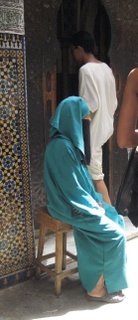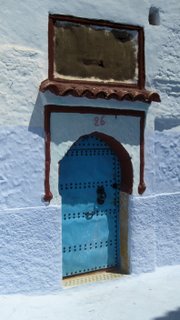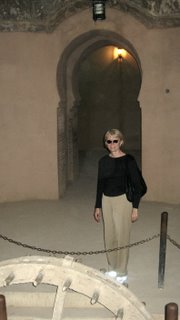
Today will be the last for awhile in exploring the Arab-Islamic, medieval city of Fès. That such a working city is being preserved is wonderful. The crafts found here are probably among the best in the world. And people actually living in the area, mixing some of the old and the new in their dress, makes it especially vital. No cars are allowed in the medina. So all transport is done by hand, push-cart, donkey, or people riding on horses. I bought a leather, gold-embossed book cover today. It's beautiful. This woman, set on some shopping, is in one of the larger squares of the medina, where copper and metal work is done. Great bronze and silver, throne-like platforms are rented to carry the bride and groom on the wedding day they appear together. The bride is brought on another decorative round platform and changes dress seven times on that day. Essentially, she is queen for a day. Earlier the bride- and groom-to-be each had experienced their own days with their respective female and male friends and family members. The library of the Kairaouine Mosque (built 857), where such celebrated scholars and teachers as Averroes, Maimonides, and Pope Sylvester II, studied and taught, was closed for two days. One day as I was leaving for an excursion, I say a woman and girl sitting with their belongings on the edge of the medina, apparently in the process of moving. While vehicles can be used outside the medina, perhaps in this case they were moving into the medina, since a man with a donkey appeared to help them move their possessions. After loading the saddlebags with various and sundry goods, a full-size refrigerator was eased on the donkey's back, balanced by the stuffed packs on each side. I continue to be astonished by the sheer physical labor done by men and women and animals in Morocco. Whether its men pushing carts through medina streets or up and down stairs with basic or no grades, women carrying agricultural produce, men bearing loads of lumber or heavy sacks of staples, everywhere individuals are involved in hard, manual work. Not to mention the donkey transporting a refrigerator to a family's new place of residence.
 Some women do dress like this. However, they are a minority; and the material is colorful not black. You can see women wearing the traditional jellaba as well as modern, western clothing-mostly on the more casual side. And there are a lot of tourists; so at least in the large cities, Moroccans are accustomed to what Americans and Europeans wear. In the Berber villages of the mountains, a woman without a head scarf is the equivalent of going topless. It's also considered indecent for men to wear shorts. But with so much trekking and no part of Morocco really undiscovered by outsiders, mountain Berbers no doubt have at least seen such dress a time or two. The vast majority of tourists are French. Not too many Americans these days. They don't know what they're missing.
Some women do dress like this. However, they are a minority; and the material is colorful not black. You can see women wearing the traditional jellaba as well as modern, western clothing-mostly on the more casual side. And there are a lot of tourists; so at least in the large cities, Moroccans are accustomed to what Americans and Europeans wear. In the Berber villages of the mountains, a woman without a head scarf is the equivalent of going topless. It's also considered indecent for men to wear shorts. But with so much trekking and no part of Morocco really undiscovered by outsiders, mountain Berbers no doubt have at least seen such dress a time or two. The vast majority of tourists are French. Not too many Americans these days. They don't know what they're missing.











